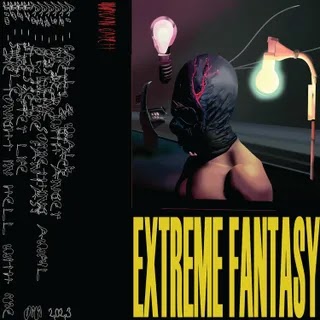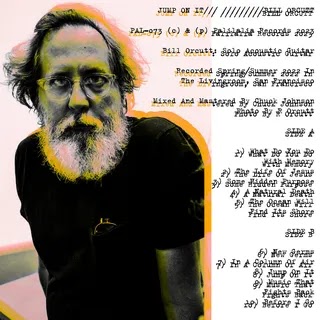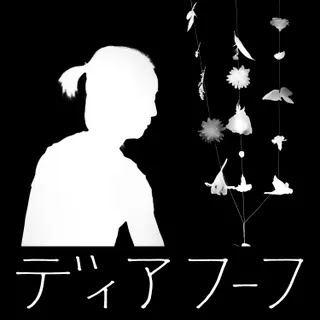The Denmark-born, Sweden-based experimentalist works with humble, home-recorded materials, but the richly expressive dimensions of her 4-track creations transcend their threadbare origins.
The title of a recent compilation neatly sums up the sound brewing in Gothenburg: Contemporary Handmade Music From Sweden. “Handmade” is the crucial term here: Artists gathered around Discreet Music—a record store, label, and distributor in the southwestern coastal city—are cobbling together an experimental style that’s distinctly homespun. DIY to the extreme, this ragtag mix of folk, field recordings, and noise suggests gummed-up tape heads, weatherbeaten guitars, and waterlogged Casio keyboards in basement studios lined with moth-eaten carpets—maybe the occasional pagan bonfire, too, given the music’s often eerie cast.
At once amateurish and avant-garde, much of this stuff could conceivably have been made at any point in the past 50 or 60 years. Blod’s contribution to the compilation, “Tillsammans,” sounds like a pair of overdubbed takes from a grade-school piano recital; Hugo Randulv’s “Cello improvisation 1” channels Arthur Russell, John Cale, and Suicide in dubbed-out buzzsaw drones; Arv & Miljö’s “Dirty deeds done dirt cheap” hums like an outboard motor. A relative newcomer to the scene, Astrid Øster Mortensen works with similarly humble materials, but the richly expressive dimensions of her 4-track creations transcend their threadbare origins. On one of her two contributions to the compilation, tape-warped harp plucks and tentative vocalizations blossom into radiant, sweeping glissandi, as though mapping out the imaginative leap implied in the song’s title: “Har ondt i halsen og går til biblioteket for at låne en bog” (“Have a sore throat and go to the library to borrow a book”). She may be “a shy kind of being,” as her other song on the collection puts it, but beneath the hush, big ideas are at play in her music.
Skærgårdslyd, Mortensen’s second long player, captures a powerful sense of presence. Like her debut, 2021’s Gro Mig En Blomst, she recorded it among the islands of the Gothenburg archipelago (Skærgårdslyd translates as “archipelago sound”). Birdsong and church bells leak through open windows; murmurs in the background, or dishes clattering on a countertop, hint at daily life going about its business. When she plays guitar, her fingers squeak against the strings, drawing your attention to the physicality of flesh and metal; when she sings, her voice distorts slightly, as though her lips were brushing against the wire mesh of the mic head.
On Mortensen’s debut, her music sometimes felt less like songs than blurry snapshots of windswept vistas, and on the new album, her sounds remain raw and rough-hewn. The opening “Igenom Livet Utan Att Såra Någon” (“Through Life Without Hurting Anyone”) begins with footsteps, wind noise, and ghostly whistling; as she stabs sternly at bright, brittle guitar chords, tinny, rapidly bowed violin descends like a fine gray mist. On “Styrsö Kyrkorgel,” a solo organ piece, reminiscent of Kali Malone’s work, that Mortensen recorded in a church on the tiny, car-free island of Styrsö, she patiently builds meditative harmonies as smooth as the floorboards beneath her. In tracks like these, the abiding sense of stasis has more in keeping with minimalism than song form.
In places, Mortensen seems intent upon developing more fully fleshed-out compositions. On the gorgeous “Hvem Er Det Som Stjæler Min Ungdom” (“Who’s Stealing My Youth”), she sings wistfully, her voice high and thin over gently plucked guitar, wrapped in a warm blanket of slap-back delay; not since Grouper’s Ruins has a mood this lonely felt so welcoming. And “Det Endnu Usagte” (“The Still Unspoken”), where she mulls a plaintive monotone melody over slowly rising piano chords, could almost pass for a cover of “Everything in Its Right Place,” as if Radiohead’s song had been fished from a tide pool after years underwater, sun-bleached and worn smooth by the waves.
These songs hint at places Mortensen’s music might go next, but for now, even her most unvarnished soundscapes remain captivating. DIY music has always prized, and sometimes fetishized, spontaneity and error, but on Skærgårdslyd, the lo-fi qualities never feel forced; they are integral to the album’s mode of expression. Often it feels like a documentary of work in progress: Tracks frequently stop mid-song, pause, and then pivot to a new melody or instrument. All these strategies come to a head on the penultimate song, “Du Finns Kvar Någonstans” (“You Are Left Somewhere”). It begins with clanging church bells, passes through a squall of tape distortion, then settles on a dulcet lullaby for piano and voice. Thirty seconds before the end, Mortensen pauses: We hear background voices, footsteps, the clanking of dishes in the sink, the beeping of a microwave. She returns to the piano but the key is different, the melody vague. It sounds as though she’s trying to recall a tune she once knew, and as the volume fades out, she’s still absent-mindedly probing at the keys. Whatever we are hearing, it’s clearly not a rehearsed performance, but something rough and unplanned—a glimpse of musical thought in the wild. It’s a reminder that music is not a polished object but a living practice. Skærgårdslyd derives its power from this unaffected intimacy: a home, a hearth, two hands, and whoever happened to be in earshot. You feel lucky to count yourself among them.
















0 comments:
Post a Comment